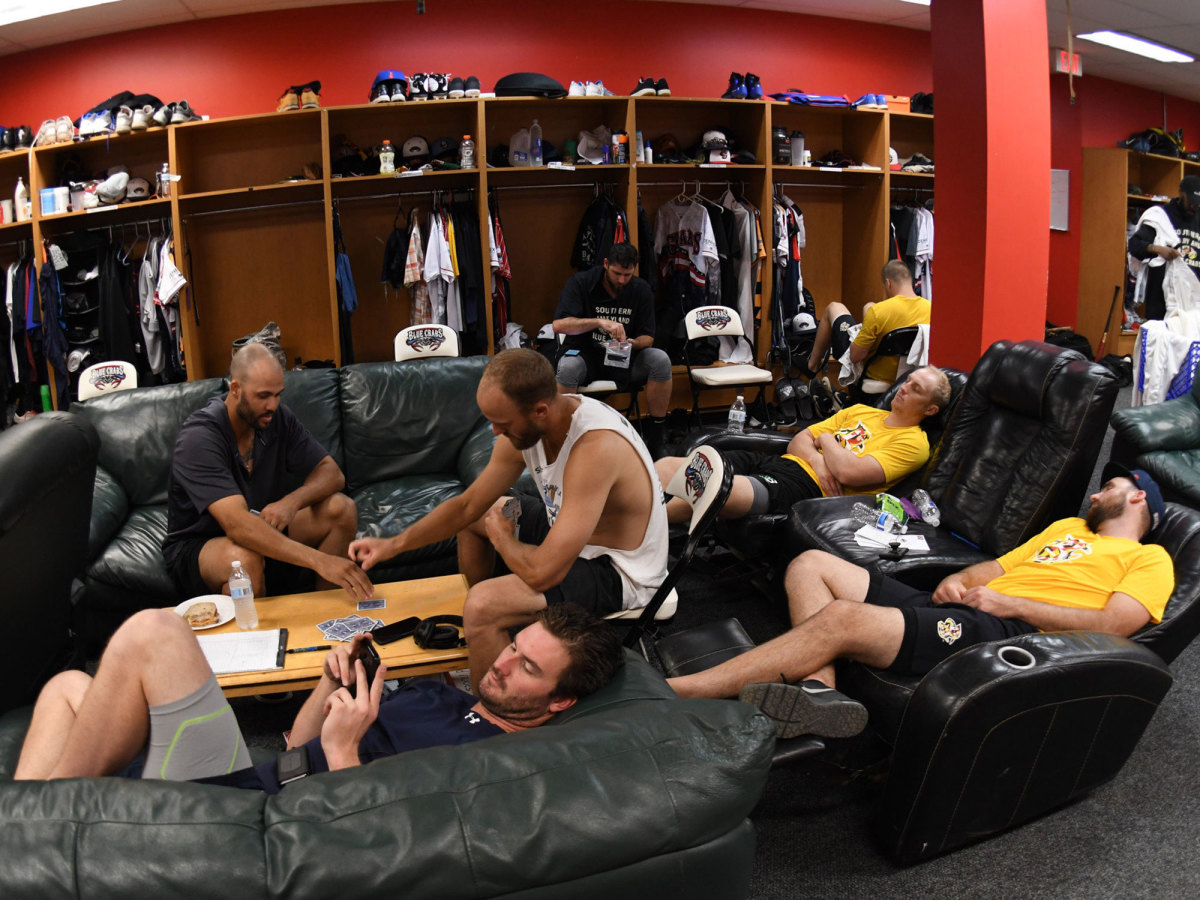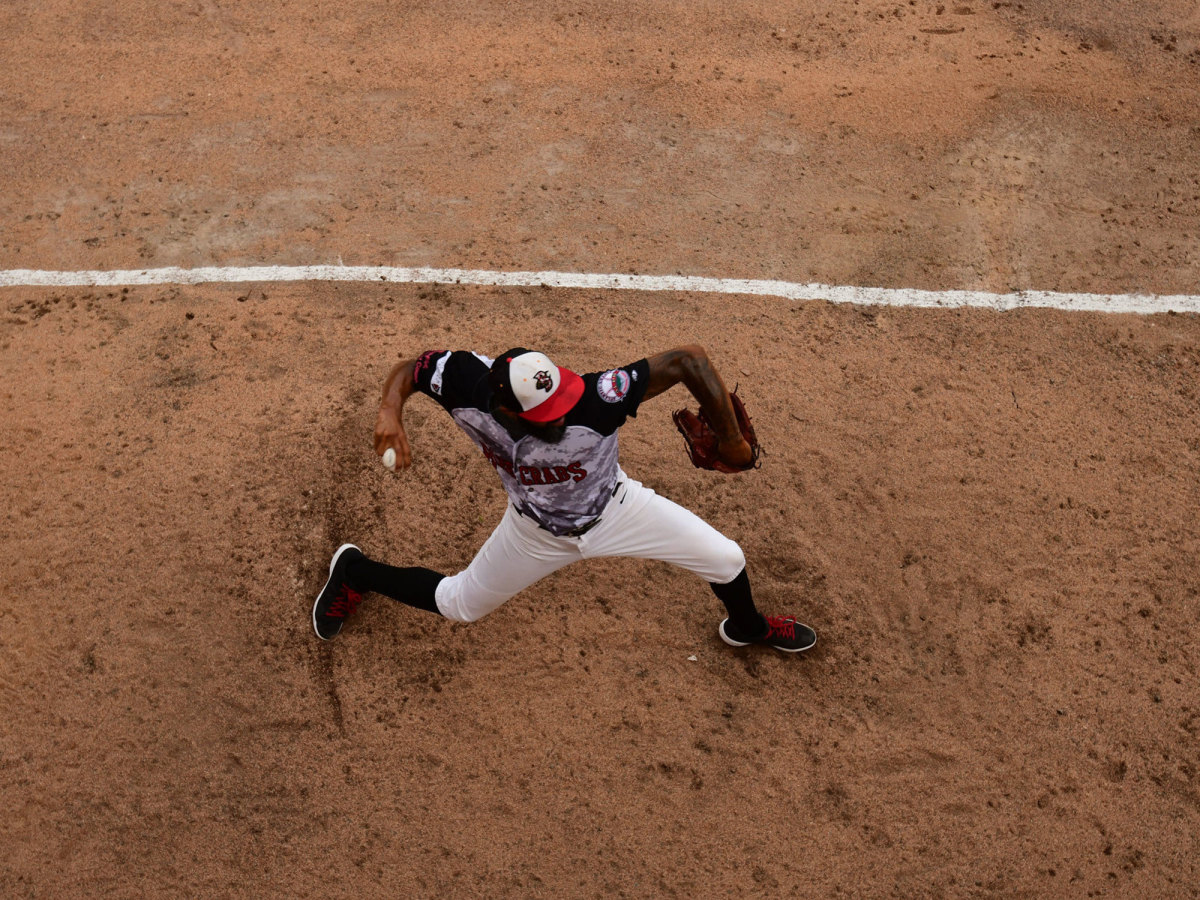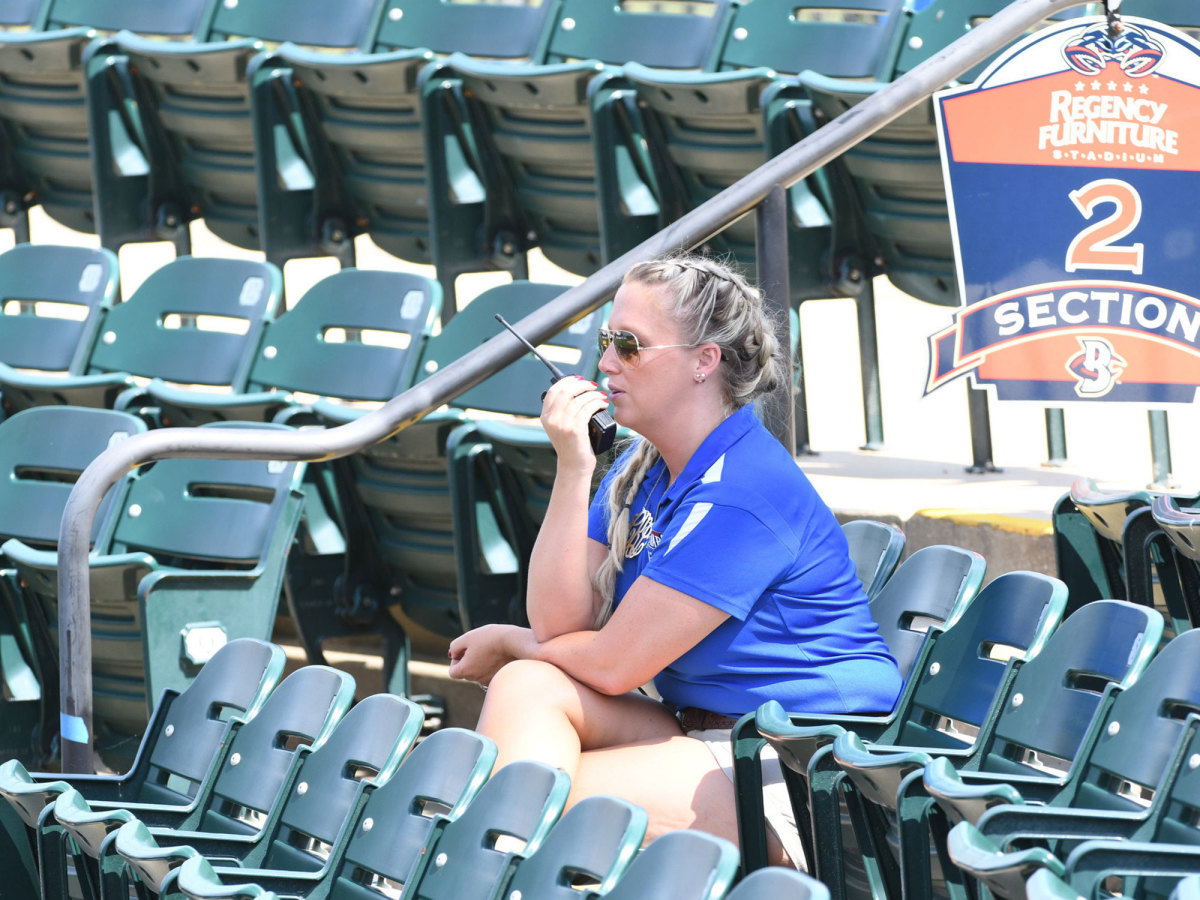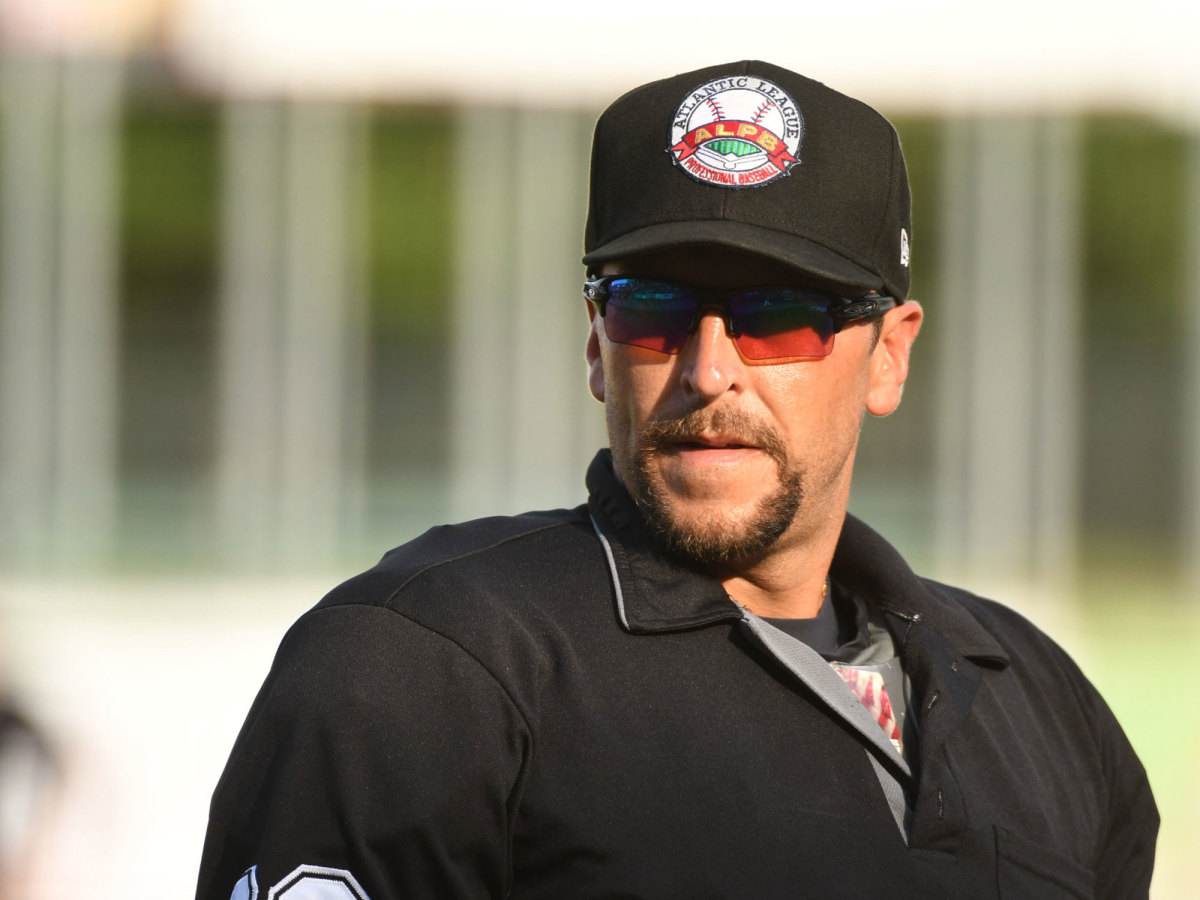How the Atlantic League Became MLB's Laboratory for the Future of Baseball

This story appears in the July 29, 2019, issue of Sports Illustrated. For more great storytelling and in-depth analysis, subscribe to the magazine—and get up to 94% off the cover price. Click here for more.
In the Southern Maryland Blue Crabs’ umpire locker room, two hours before a scheduled first pitch in early July, Tim Detwiler begins to prepare his mind for an evening of work. He does this by preparing baseballs—removing each one from its plastic wrap, rubbing it down to remove the factory gloss, setting it aside, repeating this dozens of times. Some find this part of the job tedious, but he enjoys it; there’s something soothing about the repetition. It gets him set to focus for tonight’s real tasks, he says.
Detwiler has umpired for years here in the Atlantic League. But he considered staying away this season.
“At first,” he says, “I was like, ‘Well, I’m not going back’…. Why am I going back? Now you can put a monkey back there. What’s the point?”
“I thought so, too!” Nate Caldwell, who will work behind home plate tonight, chimes in from his locker.
“It was hard not to take personal at first,” Detwiler says.
“I don’t take it personally,” Caldwell says. “But, with the way it’s going…”
The object of their skepticism is an automated strike zone, or “robo-ump,” a radar-based tracking system to call balls and strikes. It’s new this year in the Atlantic League. Just like the bigger bases. And the ban on mound visits. And the shorter breaks between innings, the limit on defensive shifts, the three-batter minimum for pitchers, the batter-friendly check-swing policy, and, oh, the ability to steal first base. (No, you did not misread that.) It’s all part of a three-year agreement with MLB, announced in March. Amid increasing discussion about all that might ail the game—too slow? too little offense? simply too boring?—Major League Baseball decided to try something new. It had tweaked the game’s rules and equipment in the past, of course. But it had never begun by testing those tweaks outside of major or minor league ball to observe their outcomes. Now, that would change. Beginning in 2019, MLB would establish new rules, implement them in independent baseball, and study the results to determine which (if any) might work in the majors. The Atlantic League is the top tier of indy ball—most players here have experience in affiliated ball, and many have appeared in MLB—and so it was a natural choice for the majors’ baseball laboratory.
To read the new rules is to see a potentially radical new vision of the game. But that’s very different from what it is to actually watch the rules in action, or, more critically, to play by them. The Atlantic League may have been cast as a testing ground, but it’s home to real players, coaches, umpires, and fans—hardly guinea pigs or crash dummies. So how does it feel to watch a game in the future of baseball? And what does it mean to play there?
Everyone in the Atlantic League has had to adjust to the changes. But these adjustments have not become the core theme of life in the league. No, that’s still what it always has been, which is waiting for the call to pack up and go somewhere else—affiliated ball, ideally. This is true for players, umpires, hell, here in Southern Maryland, even the scorekeeper left a few years back for a promotion up the road with the Double A Bowie Baysox. (The new scorekeeper is the old team chaplain.)
“Our backs are against the wall here,” says Blue Crabs manager Stan Cliburn, who has worked in indy ball for most of the past decade, after a brief major-league career as a player and a lengthy minor-league career as a coach. “We have to go show major league organizations that we still belong there. A lot of these guys have history with that.”
Cliburn’s roster has a smattering of names that you might remember from MLB (Mat Latos is the team’s closer), rounded out by many that you certainly don’t. There are former prospects, career minor-leaguers, players to be named later if at all. Some are looking for a second chance. Others feel like they never had one in the first place. But almost all are hoping to move on—which is, necessarily, to move up or move out.
Like Southern Maryland outfielder Joe Benson, who was a second-round draft pick in 2006 and a two-time entry on Baseball America’s Top 100. He made his major-league debut as a September call-up in 2011. But he never made it back. Now, he’s here, 31 years old and in his third season in the Atlantic League.
“We don’t want these rule implementations to change how we’re viewed as players, competitors, athletes,” he says. “We don’t want to be a circus act.”

For many players, the new rules don’t necessarily clash with this desire. Individually, after all, most of the changes are small. Collectively, however, they’ve sparked the question of how much experimentation might be too much—when it might threaten the foundation of trying for a second chance. This is clearest in a proposed change to move the mound back two feet, which was originally scheduled to take place after this year’s All-Star Game but has since been pushed off to be reconsidered for potential use in 2020. It would likely increase offense, making it difficult for pitchers to get the movement that they’re used to from 60 feet, 6 inches. But it would also likely require dramatic change from players, which might only make it harder for them to make the jump from here to affiliated ball.
“None of these changes yet have been too over-the-top,” says 30-year-old Blue Crabs outfielder Cory Vaughn, who spent six seasons in the minors with the New York Mets and is in his third year in the Atlantic League. “If the mound was completely different? If you think about it, that’s pitchers’ release points, that’s our timing as hitters—it would all be completely different.”
But, for now, most of the rules have required only minor adjustments. The biggest has been the lack of mound visits—which removes some dead space for fans, at the cost of a chance for a struggling pitcher to get a breather, or a quick pep talk, or a moment to refocus. Cliburn says that he’s encouraged his pitchers to create their own space here, by stepping off the mound for a second and identifying a focal spot in the stadium to get mentally re-centered, but there have still been a few times when he’s wanted to give a guy a hand and instead has had to watch him wear it.
As for the pitching coach? He tries to lead by example, because he’s also the team’s ace. Daryl Thompson has been in the Blue Crabs’ rotation since 2012, just after the last of his few appearances in the majors in 2011. Seven years later, Thompson ranks in the Atlantic League’s all-time top-ten for wins, strikeouts, and innings; this is objectively good (the numbers don’t lie) and self-evidently not (no one comes here to stick around long enough to climb a leaderboard). At 34, he’s still on top of his game: He was an easy selection for this year’s All-Star Team, he’s the league leader in strikeouts, and earlier this month, he came within two outs of the first perfect game in the history of the Atlantic League. And now he’s the team’s pitching coach, too—teaching his staff how to adjust to the new landscape while figuring it out himself.

“It’s still a learning experience,” he says. “But it’s all about how they handle themselves through it.”
Which hits on one of the league’s hopes for this grand experiment—that it will make it easier for its players to make the jump to the majors, that they’ll all be able to learn from it, that this will position them as prime targets for big-league clubs if any of these rules make it up there. There’s a feature of this explicitly designed to help draw notice to players here: TrackMan, the tracking system responsible for the automated strike zone, will record all Atlantic League players’ hitting and pitching data and send regular updates to every team in MLB, allowing them to get a sense of any player that they might find intriguing without having to send a scout to see him.
The whole thing has required some time to adapt. But players are getting there.
“Baseball is baseball, and I want to play baseball. I don’t want to be a test dummy,” says Latos, now two years removed from the last of his nine seasons in MLB, and trying to return. “But when you take a step back—this has the potential to change some things, and we get to test it out… Somebody has to do it.”
The Blue Crabs played in the Atlantic League’s first game of 2019, which meant they had the honor of being the first team to break a rule. Twice.
“It was funny—well, I don’t know if funny is the right word,” says general manager Courtney Knichel. “But, yes, we were the first team to break two rules.”
For the first one, Southern Maryland got off with a warning. Early in the game, out of habit, the catcher headed toward the starting pitcher for a chat. Not so fast. The umpire flagged him down before he’d gone too far. Mound visits, he was reminded, are not allowed unless a pitcher is injured or being removed from the game.
For the second one, the team had to pay. It looked routine—fourth inning, an easy groundball to the second baseman, standing in shallow right field, who lobbed it to first with plenty of time to spare. The runner was out. Or… not. The umpires determined that the second baseman had violated the ban on defensive shifts by being so far into the outfield, and so the runner was awarded first base.
Halfway through the year, both of these rules look a little different, subject to the kind of adjustments that come from putting a theory into practice. For defensive positioning, the league has clarified that infielders can play deep in the hole without representing a “shift.” As long as there are two fielders on either side of second base—even if they’re in the outfield—they’re in a legal formation. The mound visit ban is still in place, but there’s one exception: The battery can briefly meet to discuss signs, such as if a runner’s on second and they need to switch to a different set to prevent sign-stealing. (To make sure that they don’t discuss anything else, the ump will escort the catcher to the mound and listen in. After, he’ll motion safe, signaling that the conversation was indeed just a confirmation of signs, not a broader “mound visit.”)
Knichel, like everyone else, has watched the new rules with great interest on the field. But she’s also tasked with monitoring how they affect the situation off of it—fan engagement, players’ morale, even the fact that the restriction on time between innings means adjusting on-field entertainment. (“Nobody wants the other team to get a player to take first base because we took too long on a mascot race.”) In the Atlantic League, a general manager’s job goes far beyond roster construction and on-field strategy, and so these sorts of concerns are always front-of-mind.

The 32-year-old GM knows just about everyone in the stadium, and she knows how to do just about everything—because she has to. She sets up traffic cones in the parking lot. She’ll help pull the tarp on the field when it rains. She has to check in with the concessions manager daily. And then she has the baseball itself to contend with. (She’s not at her desk very often, but when she is, Moneyball is her go-to choice for background viewing while she works.)
The Atlantic League is built on giving everyone the chance to leave it behind, but Knichel is content to stay. She grew up here in Southern Maryland, and she’s been with the franchise since its inaugural season in 2008. After graduating from college that spring, she took a marketing internship with the brand-new team when she returned home in the summer, and she’s been here ever since, gradually working her way up and watching the club grow. Which is what she wants it to continue to do.
“I’ve been here my entire young adult life, and I want to see this franchise here forever,” she says. “Even if I’m an old lady, even if I get out of baseball, I want to drive down this road and see the lights and see the fireworks and hear the roar of the crowd.”
At any rate, this is what most fans are interested in, she says, and this is the context for audience response to the new rules. The Blue Crabs have seen an increase in attendance this year, to a nightly average above 3,000, but it’s difficult to tell how much of this, if any, can be attributed to anything related to the new rules. Most fans, Knichel figures, aren’t concerned with these nuances, and that’s fine. “The average fan is not a baseball purist,” she says. “It’s a family that wants to come out to a wholesome venue, get a couple of hot dogs, watch fireworks, go home, and put their kids to bed.” From this perspective, the changes are small; they’re only tweaks around baseball’s margins, generally imperceptible. If the game is shorter by a few minutes—or includes, on average, one additional stolen base, or a few extra hits—that doesn’t necessarily mean anything to the typical fan’s calculus of fun-versus-boredom.
But they’re all still tied to big questions: Can MLB engineer a more entertaining version of the game? Should it try to? “Entertaining” by which standards? What does success look like in this context? And what does it mean for the experimentation to happen here, in the Atlantic League?
Back in Southern Maryland's umpire locker room, Detwiler and Caldwell know that their job is supposed to be thankless; they know that no one sees them as sympathetic figures. (When Detwiler hears, “Umpires are people, too,” he puts down the baseball he’s working on and throws his head back to laugh: “No, we aren’t!”) But the automated strike zone added a new layer here.
Of every change in the Atlantic League, this might have the potential for the greatest impact—a factor in every single pitch. It might not play into a fan's idea of "fun," but it can certainly play into the idea of justice, for everyone involved. TrackMan, the “robo-ump” itself, is up behind the plate, a black box that can be seen from almost anywhere in the stadium. It creates a three-dimensional strike zone calibrated for the size and stance of each hitter; the ball’s location is recorded and near-instantaneously transmitted to the plate ump, equipped with Air Pods and an iPhone, to physically relay the machine’s call.
The Atlantic League has rolled out the system gradually, trying to work through the kinks, which go beyond achieving technical precision. They had to figure out how to send the call to the ump. (They’d originally planned for radio wave transmission—highly sophisticated walkie-talkies, essentially—before they learned that this would violate policy from the Federal Communications Commission; now, MLB has installed high-powered wi-fi modems in each stadium to ensure a strong connection to the ump’s iPhone.) They had to choose what the ump would hear. Would it be one beep for a strike and two for a ball, or a human’s words, or a machine’s? (It’s a recording of a male human voice, though the speaker’s identity is secret; even the league’s president says he doesn’t know who it is.) They had to decide if an ump would ever have the authority to override a robo-call. (Yes, in certain circumstances, such as when a curveball bounces in front of the plate and comes back up through the zone; TrackMan won’t know any better than to say “strike,” but the ump will be able to call “ball.”)

Now, the system is here. It debuted in mid-May and made its official introduction at the All-Star Game in July; by the end of this month, it will be used at every game in every park. And umpires are getting used to the idea—embracing it, even.
Caldwell was among the first group of umpires to use TrackMan. He worked behind the plate when the system went through a test in June, an “out-of-body experience,” he says. But it wasn’t bad; he didn’t feel particularly nervous about having his job taken by a robot. (After all, he figures, “TrackMan’s not going to be able to do checked swings. TrackMan's not going to be able to call interference at the plate.”) Instead, he was excited. Like anyone else in the Atlantic League, he wants to improve and move up. He works here and in NCAA Division 1, and he’s been in the Frontier League and he’s gone to umpiring school and he’s spent more than a decade with this as his full-time job. And he’s never had objective feedback on his performance, certainly not in real-time—not until TrackMan.
“I’ve seen myself work countless times on video,” he says, sitting at his locker, sipping a Pedialyte as he prepares to work his tenth straight day in 90°-heat. “But I’ve never had what major-league umpires have. I’ve never seen a plot, or a score, of my work. I mean, I’m pretty good—I think—but I’d like to know what’s really there and what’s really not. So now I’m getting instant feedback on whether it was a ball or a strike, versus what I thought.”
It was weird, he says, to be in the position of verbalizing a call that wasn’t his: “I still got the body language,” he notes, sighing huffily and twisting his shoulders in imitation of a hitter frustrated with the ump who just rang him up. And it was weird, too, to hear “ball” in his ear when the hitter had actually made late contact and fouled it off, rendering it a strike. But, mostly, it was weird to see the zone itself. By TrackMan’s definition, if any piece of the baseball crosses through any piece of the three-dimensional zone, it’s a strike. “So it could actually break around the front edge of the plate, just clip the box two-thirds of the way through, and it would still be lit up as a strike,” Caldwell says. TrackMan, of course, aims to be rid of the human biases that have forever been part of every individual strike zone—but some of those, such as the idea that a side-armer with significant horizontal movement on his pitches will be given more space east-to-west and squeezed in north-to-south, are so standard that they’re expected, by pitchers and hitters alike. This is “right” (or as close to it as it can be, with current technology), but it’s different from what players are used to. It’s all different from what everyone’s used to.
“My dad put it—you know, for a hundred years, you go to a game, you have a couple beers, you have a hot dog, you yell at the umpire when he makes a call against your team,” Detwiler says, finishing the last baseball for the day. “My old man said, who’s going to yell at the computer?”
It’s but one change in many.
“One thing about baseball,” says Caldwell, before he goes to work behind home plate—tasked with enforcing the ban on shifts, the limit on mound visits, the three-batter minimum for pitchers, the requirement to keep time between innings by yelling “twenty more seconds” to a pitcher warming on the mound rather than “four pitches left”; with the automated strike zone’s radar system positioned way above his head, not in use today, but someday soon, and then every day after—“It’s all about making adjustments. So, this? It’s just another day in the life.”
